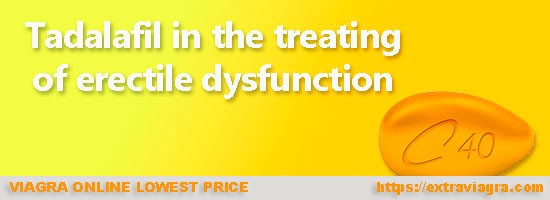Erectile dysfunction (ED) is the inability to achieve or maintain an erection that allows for coitus. In more than 67% of men, the deterioration in the quality of sexual life occurs due to erectile dysfunction. The prevalence of the disease correlates with age. ED is detected in 40% of men aged 40-50 years, in 57% – at the age of 50-60 years and in 70% – over 60 years. It is expected that by 2025, more than 300 million men will suffer from erectile dysfunction. When determining the treatment strategy, it should be taken into account that 31.5-44% of the male population remain sexually active until the age of 80. Consider the treating of erectile dysfunction on the example of tadalafil.
To date, the first-line drugs for ED therapy are phosphodiesterase type 5 inhibitors (PDE-5), which have been used for the treatment of erectile dysfunction since 1998.
During sexual stimulation, the parasympathetic nervous system is first activated, after which a relaxing factor – nitric oxide-is released from the vascular endothelium, which leads to the accumulation of cyclic guanosine monophosphate in the cavernous tissue and relaxation of the walls of the fetal arteries and cavernous bodies. The result of the active filling of the cavernous bodies of the penis with arterial blood is the compression of the venules, which allows you to block the outflow of blood, thereby provoking the appearance of an erection. It is important to note that when the intracellular activity of PDE-5 is suppressed, even a slight activation of guanylate cyclase can cause a sharp increase in the concentration of cyclic guanosine monophosphate inside the cell. As a result, the tone of the smooth muscle framework of blood vessels decreases with a further drop in blood pressure. That is why the use of nitrates is contraindicated in the appointment of PDE-5 inhibitors.
There are currently four PDE-5 inhibitors on the market: sildenafil, tadalafil, vardenafil, and udenafil. Speaking about the pharmacodynamic properties of these drugs, it is necessary to note the selectivity of their effect on PDE. Thus, sildenafil and vardenafil have similar selectivity for PDE-5. In addition, they have a weak depressing effect on PDE-1 and 6. It is known that blocking PDE-6 can provoke color perception disorders. Exposure to PDE-1 leads to side effects from the cardiovascular system. In contrast to other drugs of the discussed group, the affinity of tadalafil for PDE-1 is significantly weaker. It has been proven that this drug, which is highly selective against PDE-5, inhibits PDE-6 to a lesser extent, which minimizes the likelihood of side effects, in particular from the side of vision.
At the same time, the tadalafil molecule has a high affinity for PDE-11, which is found in muscle tissue. For this reason, patients taking tadalafil are more likely to have myalgia and back pain. However, daily intake of tadalafil in low doses (2.5–5 mg) can reduce the frequency and severity of headache, nausea, dizziness, myalgia, and redness of the face by three to five times compared to its on – demand intake at a dose of 10-20 mg. The low level of side effects of tadalafil is due to the long half-life of the drug, which allows it to be used in low doses. A number of studies have revealed the absence of serious side effects on the background of daily intake of tadalafil. In addition, it was found that against the background of long-term use of tadalafil, the frequency of side effects significantly decreased over time.
S. McMahon and co-authors analyzed the results of treating of erectile dysfunction. Of the 70 men who took taladafil (20 mg) on demand, 73% gave responses indicating a significant improvement in the quality of an erection. According to D. Hatzichristou and co-authors, patients suffering from diabetes mellitus also noted an improvement in erectile function against the background of daily tadalafil intake without pronounced changes in the level of glycated hemoglobin.

In addition to the advantages characteristic of the entire class of PDE-5 inhibitors, tadalafil has a number of unique properties. Its half-life is 17.5 hours, which provides more than 36 hours of drug action. This duration is especially relevant for young patients with high sexual activity. Daily intake of tadalafil (5 mg) allows you to maintain the therapeutic level of the drug in the body of a man, sufficient to preserve the spontaneity of sexual life and does not require prior planning of sexual intercourse. It was found that 79.2% of women preferred their partner to take tadalafil rather than sildenafil, citing a more comfortable approach to sexual contact and intimacy. Thus, the spontaneity of sexual life against the background of daily therapy with tadalafil is an important and attractive factor for most partners of men suffering from erectile disorders. In another study, it was shown that the constant intake of tadalafil 5 mg / day as an effective method of treating ED satisfied both men and their sexual partners.
Treating of erectile dysfunction – Conclusion
Thus, tadalafil in comparison with other representatives of the group of PDE-5 inhibitors has a number of undeniable advantages. First of all, this is due to the duration of its action, due to the long half-life of the drug. The constant concentration of the drug in the blood allows you to maintain the spontaneity of sexual contacts, which, of course, has a positive impact on the quality of life of both patients and their partners. In addition, tadalafil is presented in various dosages, which makes it possible to use the drug daily, increases adherence to treatment with a reduced likelihood of side effects.
